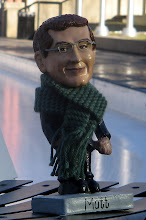Many readers may not see why any such discussion is really needed. Maybe it is a little like hearing about how the sausage is made, more than you ever want or need to know. Then again, any technical limitation (and we bass players have plenty) forces us to organize and prioritize the material - just as a poet when writing a sonnet has to form his thoughts into 10-syllable lines. And those choices can reveal a lot about the material, as well as the art and craft. Anyone whose eyes have not glazed over yet should check out Michael Hovnanian's blog, as few people besides Michael could make these subjects so thought-provoking.
 I have my own slightly geeky subject today, concerning the notation of double bass parts. In the last few years a great many editions of orchestral pieces have come out in beautiful new urtext editions, like the Mendelssohn 3rd Symphony part shown above. I wonder if we've lost something, though, by segregating the bass and cello parts which were formerly joined together, as shown below.
I have my own slightly geeky subject today, concerning the notation of double bass parts. In the last few years a great many editions of orchestral pieces have come out in beautiful new urtext editions, like the Mendelssohn 3rd Symphony part shown above. I wonder if we've lost something, though, by segregating the bass and cello parts which were formerly joined together, as shown below. This morning we had a reading of Mendelssohn 3rd, with members of the New World Symphony and The Cleveland Orchestra sharing stands. I shared a stand with Max Dimoff, the principal of Cleveland, which was a somewhat humbling experience; very few people make playing the bass seem as easy and natural as Max. I was doing my best to keep up, and also asking Max a few questions about note length, articulations, etc. - basically taking advantage of the opportunity to be a nerd and maybe learn something. Most of Max's comments and suggestions to me, though, were about other lines to listen for in the orchestra: who has a pick-up or grace note to our downbeat, where to find the pulse and which lines to intercept on our entrances.
This morning we had a reading of Mendelssohn 3rd, with members of the New World Symphony and The Cleveland Orchestra sharing stands. I shared a stand with Max Dimoff, the principal of Cleveland, which was a somewhat humbling experience; very few people make playing the bass seem as easy and natural as Max. I was doing my best to keep up, and also asking Max a few questions about note length, articulations, etc. - basically taking advantage of the opportunity to be a nerd and maybe learn something. Most of Max's comments and suggestions to me, though, were about other lines to listen for in the orchestra: who has a pick-up or grace note to our downbeat, where to find the pulse and which lines to intercept on our entrances.It occurs to me that this sort of knowledge is exactly what we mean when we talk about experienced orchestral playing. And it's probably not strictly necessary to bring Max Dimoff down to teach me these things: they can be learned from careful study of the score and recordings. (Then again, studying the example of an experienced, great orchestral player is probably one of the better ways of becoming one.) That's why as well-researched and impeccably correct as these new parts are, I really do miss having the cello part to follow along and fit with our part.
Generations of bass players have learned basic score reading in this way, and often managed to embarrass ourselves playing a line not intended for instrument. Hopefully future generations will be resourceful enough to get the score, learn other parts, and maybe embarrass themselves playing the cello parts as we did. A little educational embarrassment can be a very valuable thing.


 Technorati Link Count: no. of blog reactions to this post
Technorati Link Count: no. of blog reactions to this post
3 comments:
Really enjoyed your post!
Thanks for reading, Justin!
While it is embarrassing to accidentally play the cello line, it can also be a nice surprise to go from "you want me to play WHAT?!" to "phew, that's for the cellos!" I absolutely prefer to play parts with integrated cello/bass parts
Love your blog,
-S
Post a Comment